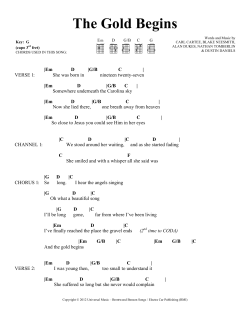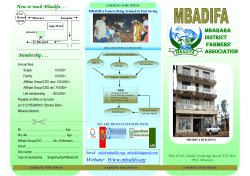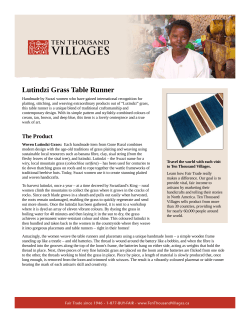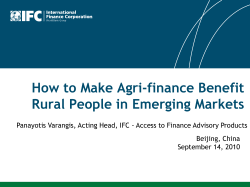
How to Maintain the Unpaved Road in Rural Area
25/05/2011 How to Maintain the Unpaved Road in Rural Area Makoto KIMURA Department of Civil and Earth Resources Engineering, Kyoto University, JAPAN kimura.makoto.8r@kyoto-u.ac.jp Civil Engineer, Geotechnical Engineer Structure foundation, Tunneling, New construction material Phase III Shore Phase I Phase II What can I do for rural people as an engineer. Offshore How do we repair without any machine? Practical construction in East Uganda September, 2007 May, 2008 Problems in rural area (Cause of the poverty) Farm River Rural road (Unpaved) Cash Crops Well Main Road (Paved) Agricultural Community Market One of the causes of the poverty in rural Can’t Transport Agricultural Product during Rainy Season Crops are spoiled Can’t get money 4 Japanese road condition about 50 years ago 6 Approach to Poverty Reduction Problems in AFRICAN Need AFRICAN Solution Solved by AFRICAN People Poverty in rural Reduce poverty Rural road Unpassable During rainy season Establish New design By manual labour With cheap, Available material Keep Trafficability By villagers Developing countries Papua New Guinea Philippines Kenya, Uganda, Tanzania Empower Expand Rural community The technology Sustainability Do-nou Empower rural (Japanese term 7 communities of soilbag) 40 cm Application of the“Do-nou” 40 cm Do-nou (Japanese term of soilbag) Thickness t = 10 cm, 20 kg ~ 25 kg Prevent floodwaters from going over dikes Application of the“Do-nou” Construction of a retaining wall with 30,000 do-nou Application of the“Do-nou” Do-nou ÌÄRNg 600 ñ 400 AX A y Ì ¤ A y Ì ¤ A y Ì ¤ A y Ì ¤ DCcP Tying the openings 1600 ` 1800 îãnclay Õ Soft N l P`Q N value = PÊFj 1~2iUnit:mm Field construction by do-nou to reinforce soft building foundation How to Generate the Strength of the ”Do-nou”? Bag External force Soil Soil is wrapped with bag Tensile strength External force applied to “do-nou” Tensile strength is generated. The soil inside the bag is reinforced. Mechanism is simple. Do-nou is the ultimate geotextile. Careful work (compaction) is necessary. Characteristics of “Do-nou” Material 40 cm x 40 cm, 10 cm, 20 kg Cheap material Plastic (polypropylene) “Do-nou” bag Bags for sugar/maize Material put inside the bag Construction Soil near the site Labor based Simple No curing period Wooden mallet Compressive pressure Bearing Capacity (250 kN) 13 Target road condition (West Kenya) Flat Width = 4.5 m Deep rut, end of rainy season Black cotton soil Traffic; tractor, car, bicycle (less than 20 cars per day) Practical Construction in West Kenya SPOT IMPROVEMENT WITH DO-NOU AT GULLY 10 cm thickness layer of gravel Item BEFORE Unit Total Width of the road m 4.0 Length of the maintained portion m 18.0 No. 300 m3 (ton) 14.0 (20) No. 40 hours 4 M 0.11 No. 2.0 Number of the used “Do-nou” Murram Participants Maintenance duration AFTER Productivity (per manhour) Length of the maintained road No. of the laid Do-nou 16 Do-nou in Ghana. 17 Communities’ response to the road maintenance using Do-nou Number of the participants Survey and Identification of the maintenance area Encourage the group to Get consensus and Arrange the required material 50 151.2 m 11 days 40 30 273.0 m 13 days 183.0 m 16 days Group A Group B Group C 20 10 0 Feb Demonstration (training of road maintenance) Mar Apr May Demonstration date Jun The number of the people who were willing to provide their labour to the road maintenance was increasing as the road has been repaired. Voice of the people who experienced road maintenance using Do-nou • Now I am confident I can maintain the road. Initially I was not very sure I could. • I am very happy because the road has brought about good positive changes to our community. • Initially I felt it was a difficult job needing a lot of energy but in the end I realized it was easy. • In the beginning we did not have idea about maintaining roads but now we have learned. • Big improvement of the road, I got knowledge. • I have got technology, idea and murram road. I can do it by myself. • I believed that the technology works on road maintenance. 19 Communities’ voice Above those were the answers from the group members, “What is a road for you?” Above those were the answers from the group members, “What is “Do-nou” technology for you?” “MICHIBUSHIN” 55 years ago in Japan Comparison road maintenance between using “Do-nou” technology and Labour based technology Technology Motivation Do-nou LBT Particiapants Target Main material Machines 1) Natural site 1) Farmers, Community soil Self Unclassified (Labour/volunteer) 1) Truck 2)Murram development (Spot) 3)Do-nou bags 1) Truck 1) Contractor Labour fee Classified 1) Murram 2) Water tank 2) Labour 3) Roller Support , Assistance Method for LBT Full size model driving tests To establish a design of the maintenance of rural roads with do-nou Measured parameters: Number of the car passes Settlement of the road surface Compaction methods in rural site Material put inside the bags Efficiency of the do-nou method 23 500200 - 250 Clay 800 1400 800 50 Gravel Clay Cross section of Case D Cross section of Case C “Do-nou” (Unit:mm) 100 times C D -100 Settlement (mm) 500 200 - 250 Gravel 0 100 200 0 1000 2000 3000 Distance from the measuring point (mm) Condition of Tests C D Before C D After 100 times passing Depth of rut (mm) Material put inside Do-nou bag 0 Depth of rut:a - b 150 mm 50 Crushed stones 100 Gravel 150 200 Sand 0 50 100 150 200 The number of the passes by car The formed rut was 150 mm deep such that it prevented the car from driving. 26 Matrix for traffic, material, maintenance and cost Coarse material Cost per meter (US$) Design Amount of traffic Material put in bag Cross section 3.0 Fine materiial Purchase material Available material Aspahlt Crusher Murram Gravel Sand Clay 3 0 18/m3 4.4/m Unit:m 20 8.3 5.5 4.0 4.0 4.0 Target Do-nou, 2 layers Do-nou, 2 layers 21.0 10.8 7.5 28.5 14.8 10.5 7.5 Do-nou, 3 layers 100 (Per day) Asphalt t=0.05 Unit : m Gravel t=0.15 Frequency of maintenance 51.0 Low High Empower community through road maintenance 5.0 m Do-nou After road maintenace with do-nou, the villagers were motivated and did repair a bridge by themselves. Hard cores Murram 1.0 m Fragments of Broken culvert Labor cost 3,000 US$ Material cost 2007.4 Negotiation with local government Contribution Volunteer 2007.8 28 APPLICATIONS TO RURAL INFRASTRUCTURE Retaining wall Culvert Log B 20 10 10 cm : Murram “Do-nou” filled with Murram 70 150 50 80 50 Log A Dam (water harvest) 29 30 TECHNICAL TRANSFER FOR BUILDING THE EMBANKMENT THROUGH THE STATE UNIVERSITY - THE PHILIPPINES 1. Demonstration of Do-nou technology to be applied to build the embankment 2. Technical transfer through the state university to the local government, NGOs Plain view Circular road Faculty of education Library Administration Faculty of Agriculture Forestry Dry season, Building embankment Stability during rainy season Coordinator Engineers Consultant services Technical transfer to the communities around the university Rainy season 31 ACCEPTANCE AND DISSEMINATION OF DO-NOU TECHNOLOGY IN THE PHILIPPINES 1.The function was sustained by the maintenance conducted by themselves 2. Dissemination and applications of Do-nou through the staff of the university Damaged by the typhoon Maintained by the engineers Appropriate/demanded technology Technical transfer through the university Case history for the other universities Retaining wall, Cement + Do-nou Dissemination to all the countries 32 The Cross Section of the Walkway with Do-nou Use sandbag bag in the whole 135 bags per 1 m 7,500 bags Active earth pressure Frictional resistance between Do-nou 900 1700 900 Do-nou 11 1 1 River gravel Loading weight is under the Failure strength? Bearing Capacity is enough?4000 3700 Allowable bearing capacity: 100 kPa 200 300 Pipe 250 500 1000 250 200 The water level in the rainy season Unit: mm Walkway Construction-1 Putting Do-nou Compacting Do-nou Compacting gravel around pipe Putting drain pipe Walkway Construction-2 Covering the surface of Do-nou with mud Putting the cement blocks Walkway Construction-3 Spraying seeds Growing grasses Rainy season COUNTRIES WHERE DO-NOU TECHNOLOGY HAS BEEN TRANSFERRED EQUATOR 37 EXPANSION OF THE RANGE OF THE ACTIVITIES No. Country Donors Area 1 Kenya SNV (Netherlands) Rural development JICA Environment conservation NGO(Fund from Toyota F., Hitachi, Mitsui Co. Ltd.) 2 Uganda JOCV (Japan Overseas Cooperation Volunteers) Community development 3 Tanzania JICA Infrastructure 4 Democratic Republic of the Congo JICA Community development 5 Cameroon Research project Agriculture 6 Viet-Num NGO(Institute for water resources) Rural development 7 The Philippines NGO (State university) Civil engineering, Fishery 8 Papua New Guinea Asian Development Bank NGO, Research project Socio-economic benefit Total length of the maintained road: 13.3 km 38 FARMERS’ RESPONSE Some farmers have built capacity and are teaching other farmers through demonstrates on how to construct and maintain roads using the Do-nou technology. Farmers involved in maintenance of roads using Do-nou technology at past agricultural field day 39 IMPACT OF THE ROAD MAINTENANCE USING DO-NOU TECHNOLOGY 1. The buyers come to the village more frequently. 2. The price of the crops, vegetable and passion fruits, have raised. 3. The income of the farmers has increased. 4. The farmers were motivated and expanded their farm. 5. The farmers became able to reach the market more early in the morning, when the price was set more highly. 6. The extension officers visit the village more frequently, then the farmers get more skill and information of the markets from them. 7. The farmers started to new project for income generation, such as fish pond. 40 MAINTENANCE OF RURAL INFRASTRUCTURES LEADING TO DEVELOPMENT OF HORTICULTURE, COMMUNITY IN KENYA 1. Rural road maintenance conducted by farmers with assistance of Min . of Agriculture and HCDA 2. Farmers’ group approached and gained the fund of local government 3. Motivation and confidence reached to the self development in social services Demonstration to the District officer done by farmers’ group made awareness, then obtained the fund. The road became passable for children. Then , the nursery school was launched. 41 THE PROJECT FOR RURAL DEVELOPMENT AND ENVIRONMENTAL CONSERVATION 4. The project for building the water harvest and nursery garden (funded by Mitsui Co. Ltd.and Hitachi) 5. Training project for Mango cultivation funded by SNV Building ponds for Irrigation (crops and nursery garden) and fish farming Nursery garden Simple & effective technology motivate people and build confidence for self development High potential of Do-nou Approach to be applied to several area (Infrastructure, Agriculture, Community development, Health, Education) 42 Yes, we can! 43
© Copyright 2025





















